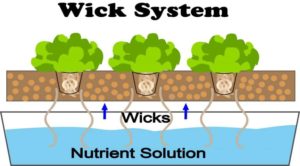What Is Wick Hydroponic System?
 The Wick Hydroponic System or wicking system hydroponics is definitely the simplest of all six types of systems, easiest to set up and the most basic form of hydroponics because there are no moving parts, doesn’t use a pump or electricity, and can be built out of everyday household items. The name Wick refers to the action of wicking to feed a water-based nutrient solution to the roots of plants.
The Wick Hydroponic System or wicking system hydroponics is definitely the simplest of all six types of systems, easiest to set up and the most basic form of hydroponics because there are no moving parts, doesn’t use a pump or electricity, and can be built out of everyday household items. The name Wick refers to the action of wicking to feed a water-based nutrient solution to the roots of plants.
The simplest of all the hydroponics systems often include a pump to aerate the nutrient solution, but it’s not required for the wick system to work but will help to aerate your nutrient reservoir and increase the supply of oxygen to the roots of your plants.
The Wick Hydroponic System is a great place for the beginner to start and learn the basic principles of hydroponics without having to deal with the complex mechanisms of other systems.
What Plants are Wick System Hydroponics best suited for?
This system has its drawbacks as being less efficient and not well equipped for high-maintenance plants, or large plants that consume a lot of water.
The best plants to use in this system are fast-growing cultivating smaller, non-fruiting plants, such as rosemary, herbs, and lettuce, that don’t require a lot of water, while thirsty plants such as tomatoes, peppers, and most fruiting crops would not do well.
How the Wick Hydroponic System Works
What you need to construct a Wick Hydroponics System:
- Growing Container (eg. a bucket)
- Reservoir for the nutrient solution (eg. a bucket)
- Growing Medium like coco coir, vermiculite, or perlite
- Wicks – strips of material like felt or good wicking rope
The wick hydroponic system works by sucking up water from the reservoir to the plants through the wick using the process of capillary action. A good wick system will have two or more good sizes of wicks to supply enough water (nutrient solution) to each plant.
The growing container that holds the plants sits right above the reservoir of water so the water doesn’t need to travel up very far along the wicks to get to the growing media with plants.
The Growing Container
 The Grow Container could be anything from a regular bucket or plastic tub to a custom-built grow tray. It will contain the plants and the growing medium. The growing medium fills up the entire tray, with seedlings transplanted directly into it, or can be separated into individual containers. You will need to make small slits or holes in the bottom of your container for the wicks to pass through.
The Grow Container could be anything from a regular bucket or plastic tub to a custom-built grow tray. It will contain the plants and the growing medium. The growing medium fills up the entire tray, with seedlings transplanted directly into it, or can be separated into individual containers. You will need to make small slits or holes in the bottom of your container for the wicks to pass through.
When designing this portion of your system, keep in mind that you will need to periodically flush out the growing medium, so to you’ll want to make sure you’ve set your growing container up so you can do this easily.
The Reservoir
 The wick system reservoir can be large or small; you just don’t want it to ever run dry. Also, you want the water level to remain high enough so the water (nutrient solution) doesn’t need to travel up the wick very far to get to the growing media and root zone.
The wick system reservoir can be large or small; you just don’t want it to ever run dry. Also, you want the water level to remain high enough so the water (nutrient solution) doesn’t need to travel up the wick very far to get to the growing media and root zone.
To discourage algae and other microbes, your reservoir should be a container that doesn’t pass light, although it doesn’t need a cover since the wicks will be dangling down into it from the growing container above.
You’ll want to top off the reservoir with the fresh nutrient solution as needed, as well as clean it out and change it completely refreshed every week or so because the strength of the nutrients diminishes as the plants absorb them.
Because the wick sucks up water and nutrients evenly, and the plants don’t use or absorb them evenly, a build-up of excess nutrient salts can build up in the growing media over time. So you’ll want to flush it with plain fresh water regularly (every couple of weeks), which will reduce the likelihood of the nutrient salts building up and reaching toxic levels for the plants.
Growing Medium
 For wick system hydroponics, it’s essential to use a growing medium that absorbs and holds moisture well, that will not drain too fast and will utilize the capillary action of the wick most effectively, as this is where the plants get all their water and nutrients from.
For wick system hydroponics, it’s essential to use a growing medium that absorbs and holds moisture well, that will not drain too fast and will utilize the capillary action of the wick most effectively, as this is where the plants get all their water and nutrients from.
 Popular growing media for wick systems are coco coir chips, perlite, and vermiculite, these are all good choices—as their lightweight structure has good wicking abilities but will not become soggy like traditional soil. Growstones are another good option since they have excellent wicking capacity.
Popular growing media for wick systems are coco coir chips, perlite, and vermiculite, these are all good choices—as their lightweight structure has good wicking abilities but will not become soggy like traditional soil. Growstones are another good option since they have excellent wicking capacity.
As with any hydroponics system, you want the plants to have plenty of moisture, but you need to make sure they’re getting a good supply of oxygen, as well.
The Wicks
The wick itself is the most important part of the wick system because, without a good absorbent wick, the plants would not get the moisture and nutrients it needs.
For the wicks, any material that is absorbent but is still resistant to rotting can be used.
String, rope, yarn, cotton, wool, felt, nylon, polyurethane or even cut-up strips of fabric, terrycloth towels or microfiber cloths are just about any absorbent material.
You should experiment with different options to determine what works best with the growing medium you are using before you begin growing your plants. Also, washing the material well before use may improve the wicking ability of the material.
The number of wicks you use will depend on the design of your system, the growing medium you use, the number of plants you are growing, and the types of plants you are growing. As a general rule, unless your setup is a small one, you should plan on using at least one wick per plant. Also, the shorter the wick the water has to go from the reservoir to the growing media and roots, the more water it can transport to the growing media.
The Aeration System (optional)
 You can install an air pump and air stone (the most common aeration system) to aerate the nutrient solution and help ensure that the plant roots are maximally oxygenated in a wick system, although it’s not isn’t necessary, it can be beneficial.
You can install an air pump and air stone (the most common aeration system) to aerate the nutrient solution and help ensure that the plant roots are maximally oxygenated in a wick system, although it’s not isn’t necessary, it can be beneficial.
The air stone, much like those found in home aquariums, is placed in the water and connected to an air pump outside the reservoir. The pump pushes air through the stone, which blows out tiny bubbles to distribute oxygen through the water. The additional oxygen in the liquid will encourage the roots to take up more nutrients and enable your plants to grow faster.
However, if you are going to use an air pump anyway, you may want to just build a deep water culture system instead.
How do I Monitor a Wick System to Keep Plants Healthy?
Danger signs to watch out for in your plants:
- slowed growth
- smaller root masses
- weak stems
- drooping, curled-in, or yellowing leaves
- lesions on plant roots or stems
- premature leaf loss
Low Maintenance
The Wick Hydroponic System is a low-maintenance system, but there are still a few things you should do to make sure your plants are healthy and happy in their growing environment.
- Regular checks that the medium is remaining consistently moist and watch out for plants that are showing signs of thirst.
The plants are not receiving a sufficient amount of nutrient solution, due to the low volume at which the liquid is delivered by the wicks.
Drier air, higher temperatures, and larger plants will require more moisture. In the case of dryness, you can add more wicks, try a different type of wick material, or switch out your growing medium to something that is more absorbent.
Are Plants Getting Enough Water
To ensure that your plants are regularly getting enough water, keep the solution level in the reservoir topped up, rather than only refilling the nutrient solution when the level gets low, so the liquid doesn’t have as far to travel up the wick.
- You should watch out for overwatering, you should still watch out for this, as it would mean your plants are not getting enough oxygen.
Make sure the growing medium isn’t soggy, and look out for mould or mildew.
To correct this problem, you can try using an aquarium pump to aerate the nutrient solution or switch out your growing medium to a type that allows the roots better access to oxygen.
- Be sure to thoroughly rinse your growing medium with fresh water every week or so to prevent the build-up of nutrients from harming your plants.
Any of the signs listed above could mean the plants are suffering from fertilizer toxicity. You can save them by immediately flushing the growing medium, and then do this more frequently as you move forward.
